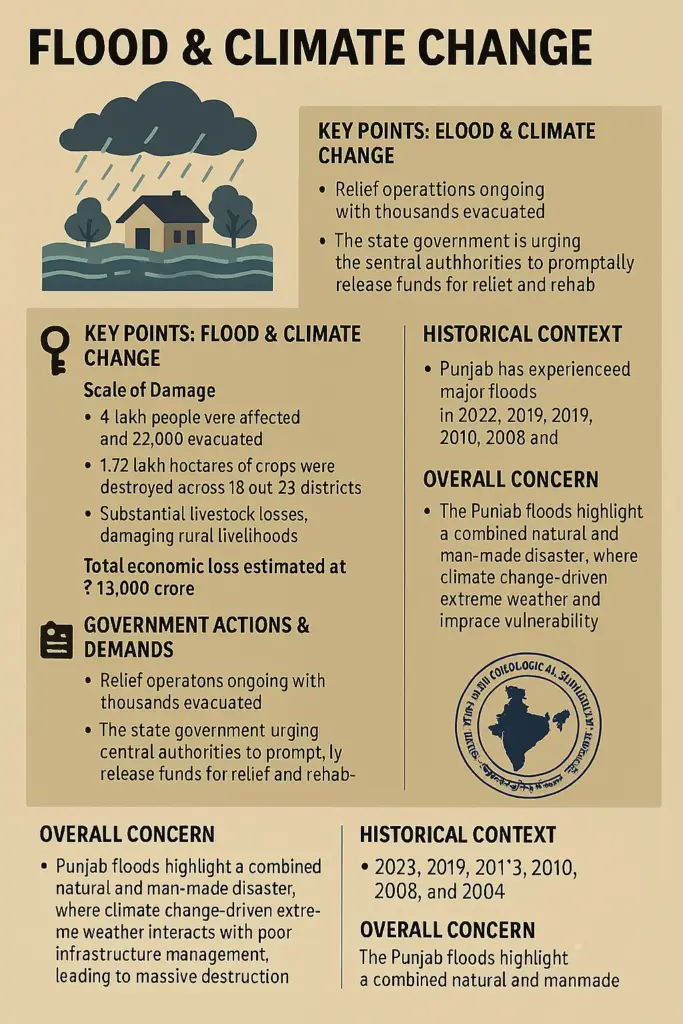September 8, 2025
Flood & Climate Change: 5 Shocking Impacts on Punjab
Flood & Climate Change
Punjab is facing one of its worst floods in five decades, impacting nearly four lakh people, causing 48 deaths, and affecting around 2,000 villages.
- The floods have resulted in an estimated economic loss of over ₹13,000 crore, with standing paddy crops destroyed just weeks before harvest.
- The situation has been aggravated by intense rainfall, swelling of rivers such as the Sutlej, Ravi, and Beas, and human activities like uncontrolled construction, sand extraction, and clogged drainage systems.
- The Finance Minister of Punjab has appealed to the Union Government to clear pending dues of ₹60,000 crore and extend extra financial support for relief and rehabilitation.
- Experts highlight that climate change and global warming are intensifying extreme rainfall events, making floods more frequent and severe.
Key Points: Flood & Climate Change
Scale of Damage:
- 4 lakh people were affected and 22,000 evacuated.
- 1.72 lakh hectares of crops were destroyed across 18 out of 23 districts.
- Substantial livestock losses, damaging rural livelihoods.
- Total economic loss estimated at ₹13,000 crore.
Heavy Rainfall & Climate Change:
- Punjab received 591.8 mm rainfall since June 24 — 53% above normal (IMD data).
- Rainfall has become irregular and intense due to global warming, particularly warming of the Arabian Sea, bringing excess moisture.
- Similar severe floods were last recorded in 1988, when over 500 lives were lost.
Major Rivers in Spate:
- Sutlej, Ravi, and Beas rivers are overflowing, submerging farmland, roads, and villages.
- Breaches in embankments and heavy water releases from reservoirs have worsened flooding.
Human-Induced Causes:
- Unregulated construction along riverbanks obstructing natural water flow.
- Blocked drainage systems due to poor planning.
- Illegal sand mining weakening embankments and riverbeds.
- Encroachments on natural water channels increase vulnerability.
Government Actions & Demands:
- Relief operations ongoing with thousands evacuated.
- The state government is urging the central authorities to promptly release funds for relief and rehabilitation.
- The Union Agriculture Minister blamed illegal mining for weakening flood protection structures.
- The Finance Minister called for better flood management systems and scientific regulation of construction and mining.
Historical Context:
- Punjab has experienced major floods in 2023, 2019, 2013, 2010, 2008, and 2004.
- Pattern shows a repeated failure in flood preparedness despite previous investments in embankment strengthening.
Overall Concern
- The Punjab floods highlight a combined natural and man-made disaster, where climate change-driven extreme weather interacts with poor infrastructure management, leading to massive destruction.
- Without scientific urban planning, regulation of mining, and upgrading of flood protection systems, such disasters are likely to become more frequent and severe.
About India Meteorological Department (IMD):
The state government is urging the central authorities to promptly release funds for relief and rehabilitation. It is crucial for managing disasters, planning agricultural activities, ensuring aviation safety, and studying climate patterns.
Key Facts:
- Established: 15 January 1875
- Headquarters: New Delhi
- Parent Ministry: Ministry of Earth Sciences (MoES)
- Current Director General (2025): Mrutyunjay Mohapatra
- Motto: Monitoring the weather to serve the nation
Major Functions of IMD:
Weather Forecasting
Provides daily, weekly, and seasonal forecasts for various sectors, especially agriculture, aviation, marine navigation, and disaster management.
Cyclone Tracking and Early Warning:
- Monitors tropical cyclones over the Bay of Bengal and Arabian Sea.
- Issues early warnings to prevent loss of life and damage to property.
Monsoon Monitoring:
- Predicts the onset, progress, and withdrawal of monsoon, crucial for India’s agriculture and water resources.
Seismology and Earthquake Monitoring:
- Operates seismological stations to detect and study earthquakes.
Climate Research and Change Monitoring:
- Examines long-term climate patterns, rising global temperatures, and severe weather events.
Aviation and Marine Meteorology;
- Provides weather information for safe flights and sea voyages.
Public Weather Services:
- Disseminates real-time weather information through apps, websites, and media.
Recent Initiatives by IMD
- Mausam App: Offers real-time weather updates to the public.
- Doppler Radar Network Expansion: Enhances tracking of cyclones and severe storms.
- Impact-Based Forecasting: Focuses on the likely effects of weather events instead of just prediction.
- Agromet Advisory Services (AAS): Provides farmers with tailored weather guidance for their specific locations.
September 9, 2025
September 8, 2025
September 4, 2025
September 1, 2025

